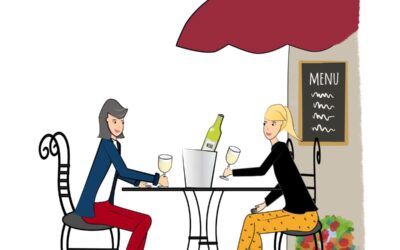After living in a foreign country for several years, it’s funny how suddenly you notice something
So imagine my surprise while having lunch with colleagues one day when I noticed something unusual: my colleagues were always putting their arms and hands on the table while eating. A big no-no in North America, I remember my mom always saying “elbows off the table!” What else hadn’t I noticed?
☞ READ MORE: French Dining Etiquette: The Ultimate Do’s and Don’ts
The History
Now table manners in France don’t include putting the full elbow on the table, but the rule is both hands must be visible. Both the Anglo-Saxon and French traditions go back to the Middle Ages, where food
In the 1600s, French King Louis XIV (aka the Sun King) didn’t trust anybody. His nobles had been plotting against him ever since he had become King at the age of 5, and he needed to take back control.
He moved his government from Paris to his new royal palace around 40km outside of Paris: the Château de Versailles. In those days, that was a day’s travel by horseback.
At Versailles, he came up with new etiquette rules, to isolate the nobles, and keep track of who was following his rules, and who wasn’t. And one of those rules was keeping your hands on the table.
He thought that he had uncovered a plot to poison him with arsenic, and so at the dining table, he ordered that everyone keep their hands visible throughout every meal.
The nobility obeyed, and as the common folk wanted to imitate the aristocracy, the rest of the country soon followed suit. So French mannerisms diverged from anglo-saxon ones by insisting that both hands be visible on the table.
☞ READ MORE: The Typical French Dinner (A not so simple guide)
France vs. North America
Today, even though there are no weapons, keeping your hands on your lap is impolite in France. Now if you are like me, all this leads to a funny little ballet, as you unconsciously put your hands away, and then re-consciously put them back! (I have stopped the fork and knife switching hands during the meal ballet, but this one is more difficult!)
Even more complicated, being an anglophone Mom, how to explain these mannerisms to young children who go back and forth between cultures?
I suppose it could be an opportunity to explain the difference between norms, the French and the English, just as the languages are different. (My kids are still aiming for eating with cutlery, so I suppose we’ll cross that bridge when we come to it!)

So what do you do in your culture? Is it still “Elbows off the table!”? Does etiquette still matter? If you enjoyed that article, you may like reading more about French dining etiquette and other table manners in France. A bientôt!
¹ Featured Image: by Matthew Henry





Thanks for your fun article! As a Japanese-American living in France, I have a strong Japanese tendency to hide my hands under the table. I didn’t know that Anglo-Saxons might have the same habit.
Thank you! I didn’t realize it was a Japanese habit as well, I’ve been to Japan twice and didn’t notice it, although I guess I wouldn’t since it is the norm for me too. It is really interesting all these little habits across cultures 🙂